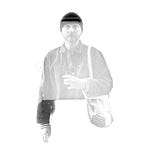The Cinephilia Of Olivier Assayas.
Olivier Assayas’ Irma Vep is a meta, self-referential piece of work, and an anti-tribute to the “magic of cinema”. Some 20 years on from initial release, the picture remains the director’s calling card, and most notable film. Parallels between the filmmakers of the Nouvelle Vague, in whom’s footsteps as an idiosyncratic filmmaker (and one-time critic of the Cahiers du cinema Assayas followed) and this are easy to draw. One character asks another “Why do we do what’s already been done, why don’t we do more personal films?”, a question that echoes Francois Truffaut’s own thoughts in his landmark essay, ‘A Certain Tendency Of The French Cinema’, the article that lit the fuse for the Nouvelle Vague, while that movement’s muse and mascot, Antoine Doinel, one of the children of Marxism and Coca Cola (as per Jean-Pierre Leaud’s turn in Godard’s Masculin Féminin) now swigs from a 2 litre plastic bottle of Coke, remoulded by Assayas in to an altogether different kind of protagonist.
Irma Vep charts the attempts of an ageing icon of the French cinema in his plan to mount a remake of Louis Feuillede’s Les Vampires. We follow things largely from the perspective of Maggie Cheung, playing a version of herself, as she traverses the landscape of the confused and troubled production.
The poetry of the backstage brings to mind Godard’s Le Mepris and Truffaut’s Day For Night, and Wim Wenders’ State Of Things. Given Assayas’ pedigree as a former editor of Cahiers du cinema it’s no surprise to find that Irma Vep is a cine-literate piece of work, with Tim Burton’s Batman Returns amongst the contemporary nods seen in the movie, while the whole thing has an air of the Rivettian about it (let’s not forget that Rivette himself was greatly influenced by Les Vampires and it’s director Louis Feuillede), with its unusual fusing of the cinephilic and the mysterious.
Despite Assayas’ following in the footsteps of the director-hailing Young Turks of the Nouvelle Vague, one has to question whether or not the Irma Vep filmmaker was anti-auteur. The importance of collaboration and the place of the technician in production is emphasised Front and centre, with the bold declaration that “Cinema is not magic” brazenly made at one point, while the “intellectual film” and concepts of state funding are heavily criticised by figures in Assayas’ world, if not by the director himself. The cinematic landscape of France in the mid-1990s was one headlined by the afterglow of the prestige picture that really came of age in the late 1980s, most typified by Claude Berri’s Jean de Florette and Manon des Sources diptych. Assayas’ film played out to this backdop of lofty, worthy expectation.
Unfortunately for Assayas, a minor revolution had swept through French cinema in between the time of his film going in to production and seeing release. It’s worth noting that France had already had the kind of vulgar renaissance longed for by the film critic character in Irma Vep just ten years prior to Assayas’ film, courtesy of the Cinéma du look, in which the likes of Luc Besson and Leos Carax reclaimed and reshaped the national cinema, but on a more contemporary note a mainstream, anti (cinematic) establishment success would be in full swing by the time Assayas’ film saw release too, thanks to Mathieu Kassovitz’s La Haine. In the case of both La Haine and Irma Vep both bring evidence to the table that a Hollywood-infused French seat-filler looks very different to the work they’re seeking inspiration from, much in the same way that the Hollywood-influenced Nouvelle Vague work of the 1960s did to their own dedications (Preminger, Hawks, Hitch, etc).
